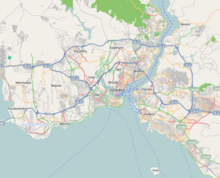
Arap Mosque is a mosque in the Karaköy quarter of Istanbul, Turkey. The building was originally a Roman Catholic church erected in 1325 by the friars of the Dominican Order, near or above an earlier chapel dedicated to Saint Paul in 1233. Although the structure was altered during the Ottoman period, it is the only example of medieval religious Gothic architecture remaining in Istanbul.

Zeyrek Mosque or the Monastery of the Pantokrator, is a large mosque on the Fazilet Street in the Zeyrek district of Fatih in Istanbul, overlooking the Golden Horn. It is made up of two former Byzantine churches and a chapel joined together and represents the best example of Middle Byzantine architecture in Constantinople. After Hagia Sophia, it is the largest Byzantine religious edifice still standing in Istanbul.

Fenâri Îsâ Mosque, known in Byzantine times as the Lips Monastery, is a mosque in Istanbul, made of two former Eastern Orthodox churches.

Gül Mosque is a former Byzantine church in Istanbul, Turkey, converted into a mosque by the Ottomans.

Church-Mosque of Vefa is a former Eastern Orthodox church converted into a mosque by the Ottomans in Istanbul. The church was possibly dedicated to Hagios Theodoros, but this dedication is far from certain. The complex represents one of the most important examples of Comnenian and Palaiologan architecture of Constantinople.

The Kefeli Mosque is a former Eastern Orthodox church, later jointly officiated by Roman Catholics and Armenians, and finally converted into a mosque by the Ottomans. The Catholic Church was dedicated to Saint Nicholas. Its date of dedication as an Eastern Orthodox church is unknown, but it is commonly identified with the 9th-century Monastery of Manuel.

Hirami Ahmet Pasha Mosque is a former Eastern Orthodox church converted into a mosque by the Ottomans. The small church, one among the 36 dedicated to Saint John the Baptist in Constantinople, was part of a monastery bearing the same name. Its full name was Saint John the Forerunner by-the-Dome. It is the smallest Byzantine church of Constantinople still extant and has never been studied.

Koca Mustafa Pasha Mosque is a former Eastern Orthodox church converted into a mosque by the Ottomans, located in Istanbul, Turkey. The church, as the adjoining monastery, was dedicated to Saint Andrew of Crete, and was named Saint Andrew in Krisei or by-the-Judgment. Although heavily transformed during both the Byzantine and the Ottoman eras, it is one of the few extant churches in Istanbul whose foundation goes back to the sixth century.

Atik Mustafa Pasha Mosque is a former Eastern Orthodox church in Istanbul, converted into a mosque by the Ottomans. In Çember Sokak in the neighbourhood of Ayvansaray, in the district of Fatih, Istanbul, it lies just inside the walled city at a short distance from the Golden Horn, at the foot of the sixth hill of Constantinople.

Sancaktar Hayrettin Mosque is part of a former Eastern Orthodox monastery converted into a mosque by the Ottomans. It is generally believed that the small building belonged to the Byzantine Monastery of Gastria. The edifice is a minor example of Palaiologan architecture in Constantinople, and is important for historical reasons.
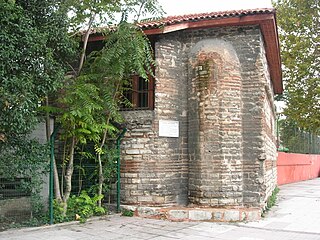
Manastır Mosque is a former Eastern Orthodox church converted into a mosque by the Ottomans. Neither archeological excavations nor medieval sources have made it possible to find a satisfactory answer as to its original dedication as a church. It is however possible that the small building was part of the Byzantine monastery dedicated to the Holy Martyrs Menodora, Metrodora, and Nymphodora, or an annex of the nunnery of Kyra Martha. The edifice is a minor example of Byzantine architecture in Constantinople, and is important for historical reasons.
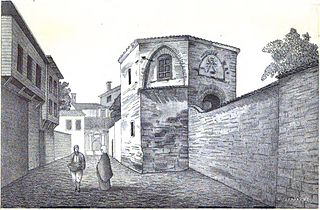
Şeyh Süleyman Mosque is a mosque in Istanbul converted from a former Byzantine building which was part of the Eastern Orthodox Pantokrator Monastery. Its usage during the Byzantine era is unclear. The small building is a minor example of architecture of the Byzantine middle period in Constantinople.
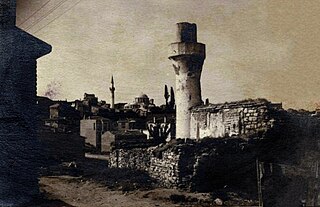
The Odalar Mosque was an Ottoman mosque in Istanbul. The building was originally a Byzantine-era Eastern Orthodox church of unknown dedication. In 1475, after the Fall of Constantinople (1453), it became a Roman Catholic church, dedicated to Saint Mary of Constantinople, until finally it was converted into a mosque by the Ottomans in 1640. The mosque was destroyed by fire in 1919, and since then has fallen into ruin. As of 2011, only some walls remain, hidden among modern buildings.

Kasım Ağa Mosque is a Byzantine building converted into a mosque by the Ottomans in Istanbul, Turkey. Neither surveying during the last restoration nor medieval sources have made it possible to find a satisfactory answer as to its origin and possible dedication. It is probable that the small building was part of the Byzantine complex and monastery whose main church was the building known in Ottoman era as the Odalar Mosque, whose dedication is also uncertain. The edifice is a minor example of Byzantine architecture in Constantinople.

Boğdan Sarayi was an Eastern Orthodox church in Turkey's largest city, Istanbul. Erected in the Byzantine era, its original dedication is unknown. In the Ottoman era the small edifice, being dedicated to St. Nicholas of Myra, was known as Agios Nikólaos tou Bogdansarághi. and was part of the Istanbul residence of the Moldavian hospodar′s legation to the Ottoman Porte. The building – whose parts above ground have almost completely disappeared – is a minor example of Byzantine architecture in Constantinople.
Toklu Dede Mosque, was an Ottoman mosque in Istanbul, Turkey. The building was originally a Byzantine Eastern Orthodox church of unknown dedication. It was almost completely destroyed in 1929.
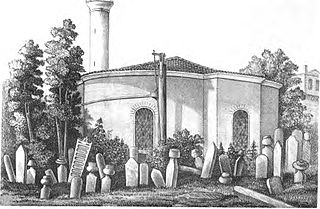
Balaban Aga Mosque was a mosque in Istanbul, Turkey, converted from a former Byzantine building. Its usage during the Byzantine era is unclear. The small edifice - pulled down in 1930 to open a new road - was a minor example of architecture of the Byzantine early period in Constantinople.
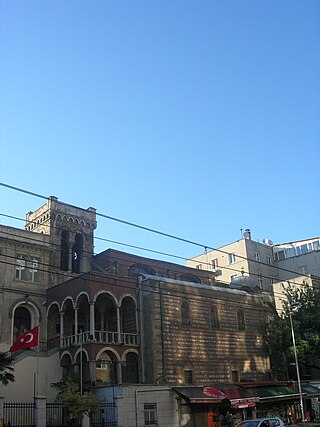
Saint Benoit is a Roman Catholic Church in Istanbul, Turkey, important for historical reasons. Established in 1427, the shrine is the oldest Catholic church of Istanbul still in use.

The Cistern of Aetius was an important Byzantine water reservoir in the city of Constantinople. Once one of the largest Byzantine cisterns, it is now a football stadium in Istanbul. Since 1928 it has been known as Karagümrük stadyumu, 'Karagümrük stadium' or Vefa stadyumu, 'Vefa stadium', while in the Ottoman period it was known as the Turkish: Çukurbostan, lit. 'sunken garden'.

The Cistern of Aspar or Great Cistern, known in Turkish as Sultan Selim Çukurbostanı, was a Byzantine open-air water reservoir in the city of Constantinople.


